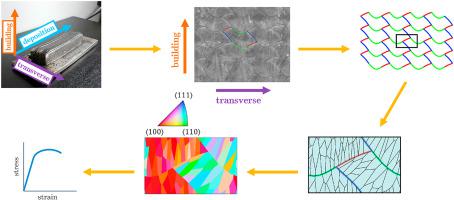当前位置:
X-MOL 学术
›
Mech. Mater.
›
论文详情
Our official English website, www.x-mol.net, welcomes your
feedback! (Note: you will need to create a separate account there.)
Microstructural modeling of anisotropic plasticity in large scale additively manufactured 316L stainless steel
Mechanics of Materials ( IF 3.4 ) Pub Date : 2021-02-01 , DOI: 10.1016/j.mechmat.2020.103664 T.F.W. van Nuland , J.A.W. van Dommelen , M.G.D. Geers
Mechanics of Materials ( IF 3.4 ) Pub Date : 2021-02-01 , DOI: 10.1016/j.mechmat.2020.103664 T.F.W. van Nuland , J.A.W. van Dommelen , M.G.D. Geers

|
Abstract In this paper, the anisotropic mechanical response triggered by specific microstructures encountered in wire + arc additively manufactured 316L stainless steels is analyzed. For this purpose, a representative volume element is generated, with an internal geometry that is based on an average periodic fusion zone shape. The large columnar grain geometry with different preferred directions within a single fusion zone is reconstructed with an anisotropic Voronoi algorithm. Grain orientations are extracted from experimental data of different regions within a single sample. Crystal plasticity finite element simulations are performed to predict the macroscopic yield behavior under various loading angles. It is observed that the anisotropic response varies significantly within a single sample, which is essentially caused by differences in the texture. A spatial correlation between the orientation of a grain and its location within the fusion zone is identified, allowing to distinguish clusters of grains with a similar orientation. As a result, strain localizes in a global shear band across the entire height of the fusion zone, which prominently influences the macroscopic response. A comparison of the results relative to a standard isotropic Voronoi grain geometry shows that the elongated geometry of the grains does not influence the macroscopic yield behavior significantly. The local crystallographic orientations are dominating instead, whereby the correlation between location and orientation of grains has to be taken into account.
中文翻译:

大规模增材制造 316L 不锈钢各向异性塑性的微观结构建模
摘要 本文分析了焊丝+电弧增材制造的316L不锈钢中由特定微观结构引发的各向异性机械响应。为此,生成具有基于平均周期性融合区形状的内部几何形状的代表性体积元素。使用各向异性 Voronoi 算法重建单个融合区内具有不同优选方向的大柱状晶粒几何形状。晶粒取向是从单个样品内不同区域的实验数据中提取的。执行晶体塑性有限元模拟以预测各种加载角度下的宏观屈服行为。观察到单个样品内的各向异性响应变化显着,这主要是由质地的差异引起的。确定晶粒取向与其在融合区内的位置之间的空间相关性,从而允许区分具有相似取向的晶粒簇。结果,应变集中在整个融合区高度的全局剪切带中,这对宏观响应有显着影响。结果与标准各向同性 Voronoi 晶粒几何形状的比较表明,晶粒的细长几何形状不会显着影响宏观屈服行为。相反,局部晶体取向占主导地位,因此必须考虑晶粒位置和取向之间的相关性。确定晶粒取向与其在融合区内的位置之间的空间相关性,从而允许区分具有相似取向的晶粒簇。结果,应变集中在整个融合区高度的全局剪切带中,这对宏观响应有显着影响。结果与标准各向同性 Voronoi 晶粒几何形状的比较表明,晶粒的细长几何形状不会显着影响宏观屈服行为。相反,局部晶体取向占主导地位,因此必须考虑晶粒位置和取向之间的相关性。确定晶粒取向与其在融合区内的位置之间的空间相关性,从而允许区分具有相似取向的晶粒簇。结果,应变集中在整个融合区高度的全局剪切带中,这对宏观响应有显着影响。结果与标准各向同性 Voronoi 晶粒几何形状的比较表明,晶粒的细长几何形状不会显着影响宏观屈服行为。相反,局部晶体取向占主导地位,因此必须考虑晶粒位置和取向之间的相关性。应变位于整个融合区高度的全局剪切带中,这显着影响了宏观响应。结果与标准各向同性 Voronoi 晶粒几何形状的比较表明,晶粒的细长几何形状不会显着影响宏观屈服行为。相反,局部晶体取向占主导地位,因此必须考虑晶粒位置和取向之间的相关性。应变位于整个融合区高度的全局剪切带中,这显着影响了宏观响应。结果与标准各向同性 Voronoi 晶粒几何形状的比较表明,晶粒的细长几何形状不会显着影响宏观屈服行为。相反,局部晶体取向占主导地位,因此必须考虑晶粒位置和取向之间的相关性。
更新日期:2021-02-01
中文翻译:

大规模增材制造 316L 不锈钢各向异性塑性的微观结构建模
摘要 本文分析了焊丝+电弧增材制造的316L不锈钢中由特定微观结构引发的各向异性机械响应。为此,生成具有基于平均周期性融合区形状的内部几何形状的代表性体积元素。使用各向异性 Voronoi 算法重建单个融合区内具有不同优选方向的大柱状晶粒几何形状。晶粒取向是从单个样品内不同区域的实验数据中提取的。执行晶体塑性有限元模拟以预测各种加载角度下的宏观屈服行为。观察到单个样品内的各向异性响应变化显着,这主要是由质地的差异引起的。确定晶粒取向与其在融合区内的位置之间的空间相关性,从而允许区分具有相似取向的晶粒簇。结果,应变集中在整个融合区高度的全局剪切带中,这对宏观响应有显着影响。结果与标准各向同性 Voronoi 晶粒几何形状的比较表明,晶粒的细长几何形状不会显着影响宏观屈服行为。相反,局部晶体取向占主导地位,因此必须考虑晶粒位置和取向之间的相关性。确定晶粒取向与其在融合区内的位置之间的空间相关性,从而允许区分具有相似取向的晶粒簇。结果,应变集中在整个融合区高度的全局剪切带中,这对宏观响应有显着影响。结果与标准各向同性 Voronoi 晶粒几何形状的比较表明,晶粒的细长几何形状不会显着影响宏观屈服行为。相反,局部晶体取向占主导地位,因此必须考虑晶粒位置和取向之间的相关性。确定晶粒取向与其在融合区内的位置之间的空间相关性,从而允许区分具有相似取向的晶粒簇。结果,应变集中在整个融合区高度的全局剪切带中,这对宏观响应有显着影响。结果与标准各向同性 Voronoi 晶粒几何形状的比较表明,晶粒的细长几何形状不会显着影响宏观屈服行为。相反,局部晶体取向占主导地位,因此必须考虑晶粒位置和取向之间的相关性。应变位于整个融合区高度的全局剪切带中,这显着影响了宏观响应。结果与标准各向同性 Voronoi 晶粒几何形状的比较表明,晶粒的细长几何形状不会显着影响宏观屈服行为。相反,局部晶体取向占主导地位,因此必须考虑晶粒位置和取向之间的相关性。应变位于整个融合区高度的全局剪切带中,这显着影响了宏观响应。结果与标准各向同性 Voronoi 晶粒几何形状的比较表明,晶粒的细长几何形状不会显着影响宏观屈服行为。相反,局部晶体取向占主导地位,因此必须考虑晶粒位置和取向之间的相关性。











































 京公网安备 11010802027423号
京公网安备 11010802027423号